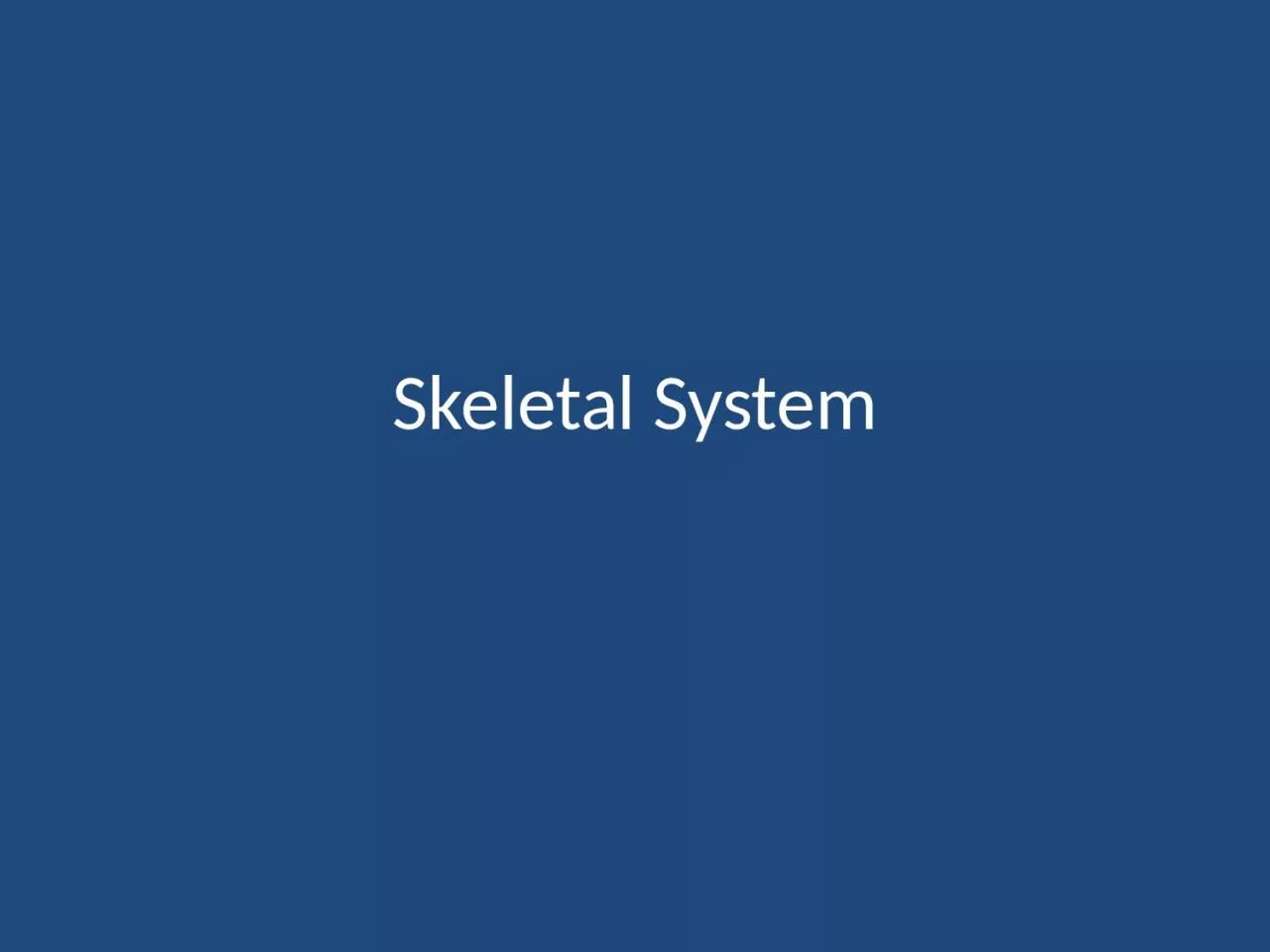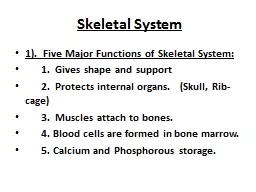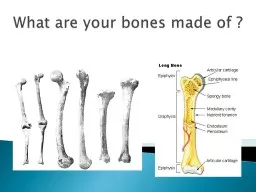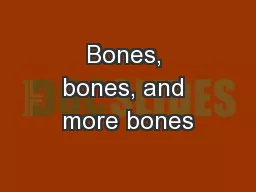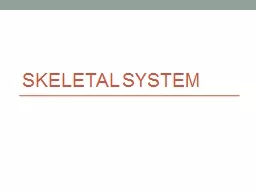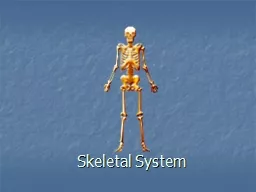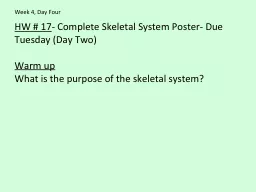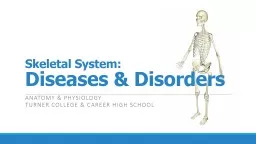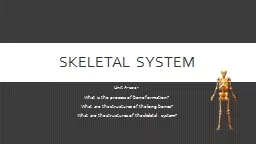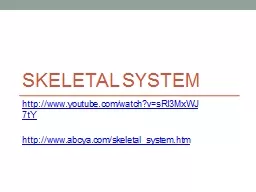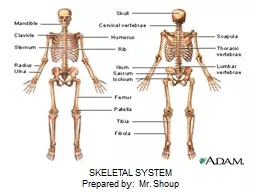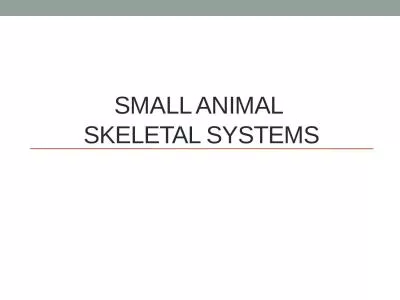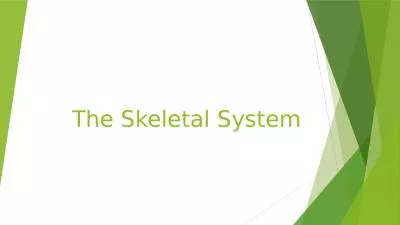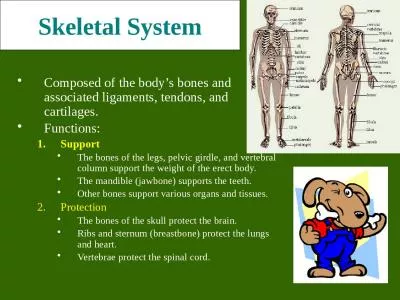PPT-Skeletal System The skeletal system is composed of 206 bones.
Author : finley | Published Date : 2024-02-16
The skeletal system provides 1 protection 2support 3 production of red blood cells 4 movement 5 Triglyceride Storage yellow fat 6 Storing Minerals Bones are attached
Presentation Embed Code
Download Presentation
Download Presentation The PPT/PDF document "Skeletal System The skeletal system is c..." is the property of its rightful owner. Permission is granted to download and print the materials on this website for personal, non-commercial use only, and to display it on your personal computer provided you do not modify the materials and that you retain all copyright notices contained in the materials. By downloading content from our website, you accept the terms of this agreement.
Skeletal System The skeletal system is composed of 206 bones.: Transcript
The skeletal system provides 1 protection 2support 3 production of red blood cells 4 movement 5 Triglyceride Storage yellow fat 6 Storing Minerals Bones are attached to other bones by ligaments. Lucie Shawcross * Intro to Bones * Exercise Science Majors. Main Menu. Main menu. APPENDICULAR SKELETON. PECTORAL GIRDLE. UPPER BODY 1. UPPER BODY 2. UPPER BODY 3. PELVIC GIRDLE. LOWER BODY 1. LOWER BODY 2. 1. Gives shape and support. 2. Protects internal organs. (Skull, Rib-cage). 3. Muscles attach to bones.. 4. Blood cells are formed in bone marrow. . 5. Calcium and Phosphorous storage. . http://kidshealth.org/kid/htbw/SSmovie.html. What are your bones made of ?. Mineral salts. Water. Tissue. Inside a Bone. By shape:. Long bones . Short bones. Flat bones. Sesamoid. bones. Irregular bones. Bone T. ypes. Osseous tissue (bone tissue):. Wednesday Dec 7. Bone Classification. The skeleton can be divided into . ______ . broad categories based on their individual shapes. Objective: To learn the categories and be able to put various bones into their appropriate category.. Quietly find your seat and get ready for class. Hand in skeleton projects below on chair. Fun Questions. How many bones are in the human body?. Have you ever broken a bone?. What is the largest bone in your body?. Provides shape and support.. Enables us to move.. Protects your internal organs.. Produces blood cells.. Stores minerals such as calcium and phosphorous.. Bone Formation and Growth. As a baby, most of your skeletal system is made up of cartilage.. Warm up. What is the purpose of the skeletal system?. Week 4, Day Four. Warm up Response . Purpose:. to provide structure and support to the human body. Bones are where new blood cells are generated (in the marrow), and require the mineral . Anatomy & Physiology. Turner college & career high school. Our skeletal system provides a framework for the muscles and helps in the basic function of movement. .. However. , due to age and various other factors, the bones become weak and fragile and may get affected by some common disorders.. What is the process of bone formation?. What are the structures of the long bones?. What are the structures of the skeletal system? . The skeletal system. Compromises the bony framework of the body.. http://. www.abcya.com/skeletal_system.htm. S. k. e. l. e. t. a. l. System. Objective. : By the end of the lesson students will be able to list (3) bones in the body, as well as explain (2) functions of the skeletal system.. Shoup. Skeletal System. Know 4 of the 6. Six Purposes for the Skeletal System. 1. Support. 2. . Movement with muscle function. 3. Shape. 4. Marrow-Yellow/Red Red/White Blood Cells. 5. Protection-Flat bone. Functions of the Skeletal System. Form. Protection. Support. Strength. How does it work?. Bone. - Hard tissue that supports and protects other organs. Cartilage. - . Firm, flexible tissues that . All of the bones in your body make up the skeletal system. There are 206 bones in an adult’s human body (at birth, you had more than 300 bones!). A . skeleton. is a framework of living bones that supports your body. Functions:. Support. The bones of the legs, pelvic girdle, and vertebral column support the weight of the erect body.. The mandible (jawbone) supports the teeth.. Other bones support various organs and tissues..
Download Document
Here is the link to download the presentation.
"Skeletal System The skeletal system is composed of 206 bones."The content belongs to its owner. You may download and print it for personal use, without modification, and keep all copyright notices. By downloading, you agree to these terms.
Related Documents

